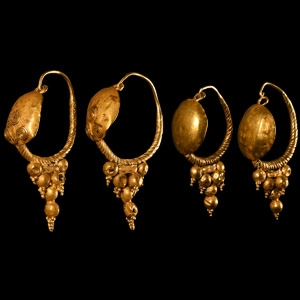Home > Auctions > 3 - 8 September 2024
Ancient Art, Antiquities, Natural History & Coins
Auction Highlights:
Property of the vendor's grandfather, thence by family descent, circa 1985.
From the private collection of a New York, USA gentleman.
Collected from 1970-1999.
From the collection of the late Mr S.M., London, UK.
Acquired in Europe before 2001.
This lot has been checked against the Interpol Database of stolen works of art and is accompanied by search certificate number no.11857-206794.
From a collection acquired on the UK art market from various auction houses and collections mostly before 2000.
From an important Cambridgeshire estate; thence by descent.
Cf. Tassinari, S., La Vaisselle de Bronze, Romaine et Provinciale, au Musée des Antiquités Nationales, XXIXe supplément de Gallia, Paris, 1975, items 152, 173, 173, 178, for type.
This type of bronze handles are usually depicting mythological scenes. The scene of the putto riding a donkey is often linked to Bacchic processions. The face of the character riding the donkey could also correspond to that of Silenus, who in the same processions is often represented riding such an animal.
Private UK collection.
Acquired in the 1980s.
Property of a Cambridgeshire gentleman.
Cf. Bussière, J., Lindros Wohl, B., Ancient Lamps in the J. Paul Getty Museum, Malibu, 2017, no.526, for type.
Ex property of an Austrian private collector since the 1970s.
See Mackreth, D.F., Brooches in Late Iron Age and Roman Britain, Oxford, 2011, figs.7546, 7621, 12545, for the type.
The knee brooches, especially in Britain, are connected to military sites, like the Hadrian’s Wall. The British types evolved after the continental versions appeared in Britannia, possibly having been imported by Noricum’s soldiers.
Property of an Essex, UK, lady; received by descent from her grandfather.
Cf. Marshall, F.H., Catalogue of the Jewellery, Greek, Etruscan and Roman, in the Department of Antiquities, British Museum, London, 1911, pl.LII, item 2377, for type.
From a collection acquired on the UK art market from various auction houses and collections mostly before 2000.
From an important Cambridgeshire estate; thence by descent.
Collected from 1970-1999.
From the collection of the late Mr S.M., London, UK.
Cf. Porat, R., Davidovich, U., Langford, B., Zissu, B., 'Votive Offerings from the Late Roman Period in the Te' omim Cave, Western Jerusalem Hills' in Taal, O., Weiss, Z., Expression of Cult in Southern Levant in the Greco-Roman period, Turnhout, 2017, pp.111-130.
The lamp seems to be a variant of the type Beit Nattif lamps, usually with pyramidal handle (here substituted by a head of a saint or Christ) and a reddish slip on the upper part. This was the most widespread type of lamps in use in Judaea in the Late Roman Period.
Property of a Gloucestershire, UK, collector.
Property of an East Sussex, UK, gentleman.
See similar mounts in shape of eagle from Cerne Abbas, in Worrell, S., Worrell, 'Roman Britain in 2005. II. Finds reported under the Portable Antiquities Scheme', in Britannia, 37 (2006), pp.429-466, p.457, fig.27
The function of the animal head terminal in the form of a stylised eagle or griffin head found in the canabae at Caerleon was interpreted as a possible pommel for a sword or other weapon due to the rectangular hole at the top of the head for a tang or other attachment.
Private collection, England.
Cf. Ruseva-Slokoska, L., Roman Jewellery, Sofia, 1991, item 247, for type.
Acquired between 1950-1970s.
Ex Swiss private collection.
Cf. The Metropolitan Museum, New York, accession number 08.251.5, .6, for a broadly similar earring.
553 - 564 of 3369 LOTS

.jpg)

.jpg)
.jpg)
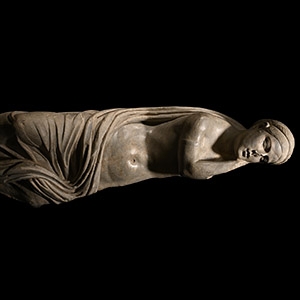
.jpg)
.jpg)


.jpg)

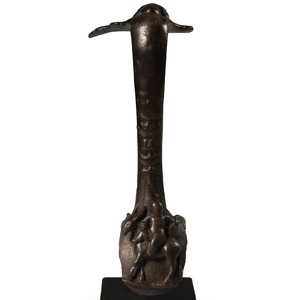

.jpg)
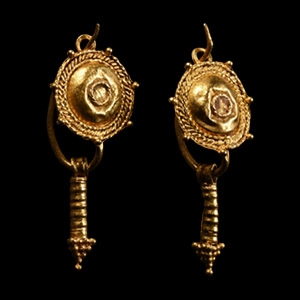
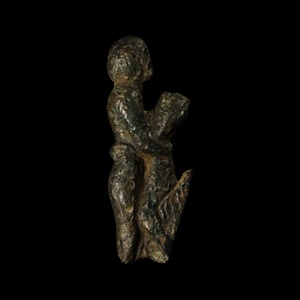

.jpg)

